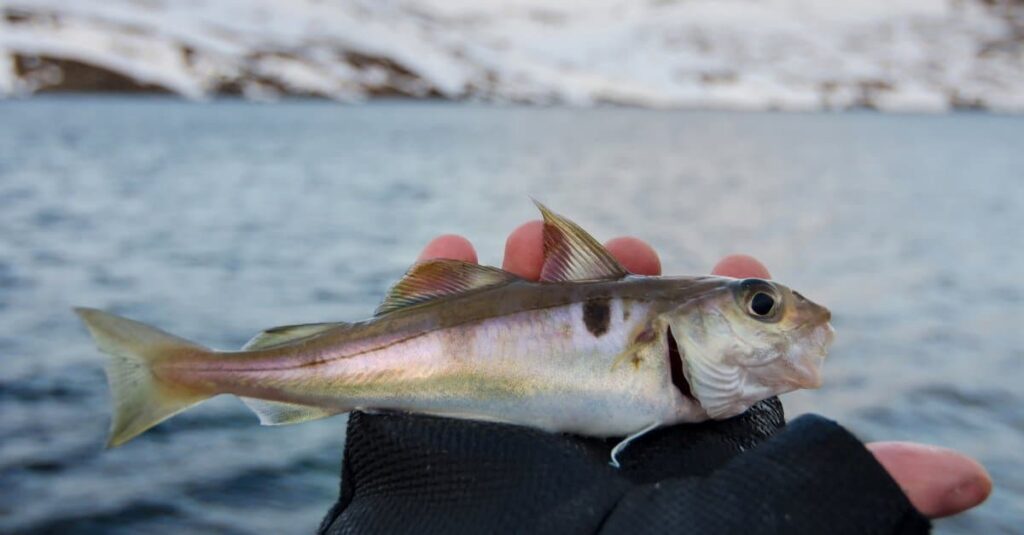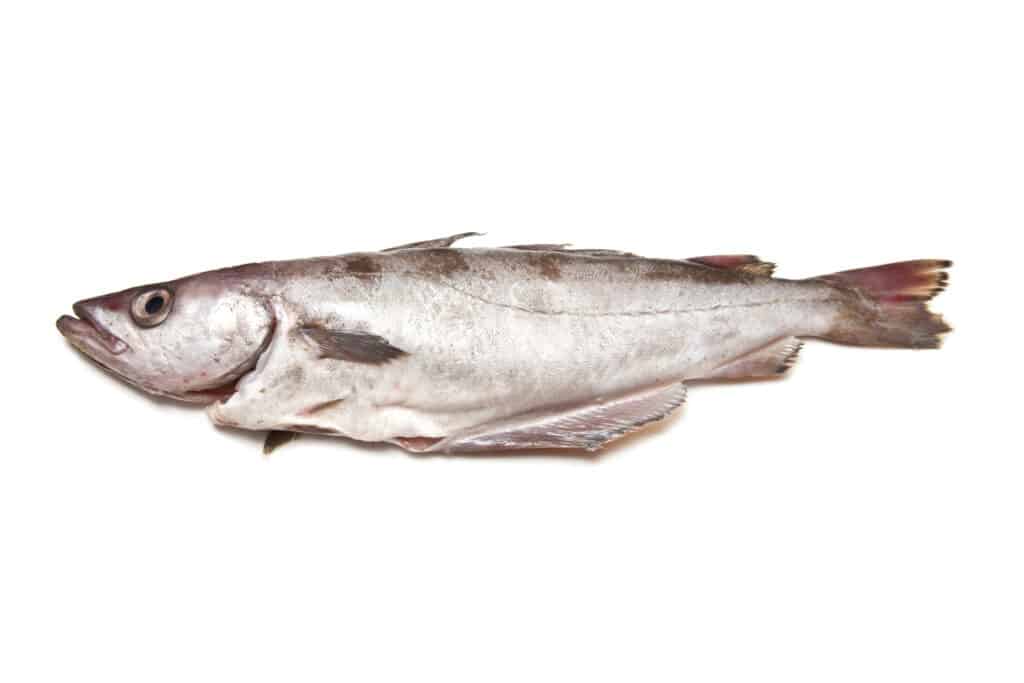Several types of whitefish are popular among recreational anglers, but pollocks and haddocks are known worldwide. They both belong to the so-called Gadidae family of true codfish. Pollocks belong to a genus called Pollachius, which includes two cod species: the Atlantic pollock and saithe, sometimes called the Boston Blue. Haddocks are classified under Melanogrammus with only one species: the Melanogrammus aeglefinus.
Although both are very popular for recreational and commercial fishing, they have distinct features that can help you distinguish them. Today, we will determine the similarities and differences between pollocks and haddocks.
Comparing Pollock vs. Haddock
| Pollock | Haddock | |
|---|---|---|
| Size | Length: 12 to 42 inches (1 to 3.5 feet) Weight: Up to 35 pounds (16 kg) | Length: 12 to 36 inches (1 to 3 feet) Weight: 2 to 40 pounds |
| Appearance | Elongated bodies with strongly defined silvery scales on their sides | – Elongated bodies with distinguishable coloring, having purplish or blackish lines along the back – A distinctive marking between the lateral line and the pectoral fin |
| Habitat | On or near the bottom of seas | On or near the bottom of lakes and seas |
| Distribution | Widely distributed within the Northeast Atlantic Ocean and also abundant within the Bay of Biscay | Found on both sides of the North Atlantic from Cape May, Georges Bank, New Jersey, Newfoundland, and the Gulf of Maine |
| Diet | They are carnivores that feed mainly on planktonic crustaceans and will begin to feed on larger prey as they mature, such as small fish and squid | These carnivores eat bottom-dwelling animals such as crustaceans, mollusks, worms, sea urchins, sea stars, and even fish eggs |
| Predators | Salmon sharks, sleeper sharks, seabirds, sea lions, other fish | Skates, Spiny dogfish, gray seals, and other groundfish such as pollock and cod |
| Lifespan | 12 to 15 years | 10 or more years |
The Key Differences Between Pollocks and Haddocks
Sometimes we can mistake one fish for another, and pollocks and haddocks are no exception. At first glance, they may look similar; that’s why people often cannot tell them apart. Still, we can highlight their differences with the help of some key features. These differences include appearance, size, diet, distribution, reproduction, and lifespan.
Pollock vs. Haddock: Appearance

The haddock is usually distinguished by its black lateral line that runs along its white side.
©Piotr Wawrzyniuk/Shutterstock.com
One of the easiest ways to tell a pollock and a haddock apart is through their appearance. They have distinct physical features that can help tell which is which.
The pollock can be distinguished by its torpedo-shaped body and crooked lateral line. It has widely-separated dorsal fins with anal fins and a small chin barbel.
On the other hand, the haddock is usually distinguished by its black lateral line that runs along its white side. It has three dorsal fins, two anal fins, and a white belly to complete its unique look. It also has one notable feature, the “Devil’s thumbprint,” a distinctive dark blotch above its pectoral fin.
Pollock vs. Haddock: Size

The pollock has a total length of 12 to 42 inches.
©iStock.com/PicturePartners
Highlighting the pollocks and haddocks’ size is another easy way to differentiate them. The pollock has a total length of 12 to 42 inches and can weigh up to 35 pounds (16 kg).
The haddock has a total length of 12 to 36 inches (1 to 3 feet) and can weigh 2 to 40 pounds (0.9 to 3.18 kg) at maturity. It grows rapidly and matures at a young age. It can double its size within a short period.
Pollock vs. Haddock: Diet

A haddock’s diet consists of bottom-dwelling animals.
©Steven G. Johnson / CC BY-SA 3.0 – License
Pollocks and haddocks have different diets, although both are carnivorous fish. When they’re young, pollocks feed on planktonic crustaceans, such as krill. They start feeding on larger prey when they are older, such as small fish and squid.
A haddock’s diet consists of bottom-dwelling animals, such as mollusks, crustaceans, worms, sea urchins, and sometimes fish eggs. Some adult haddocks feed on small fish, especially herring.
Pollock vs. Haddock: Distribution
Pollocks are mostly found in the Northeast Atlantic Ocean and are abundant in the Bay of Biscay. Meanwhile, haddocks are found on both sides of the North Atlantic. In the western North Atlantic, they’re common in Newfoundland, Cape May, and New Jersey. Haddocks are abundant in the Gulf of Maine and on Georges Bank.
Pollock vs. Haddock: Predators

Pollocks are hunted by salmon sharks, sleeper sharks, sea lions, seabirds, aquatic mammals, and other fish.
©iStock.com/EddWestmacott
Both pollocks and haddocks have predators. Pollocks are hunted by salmon sharks, sleeper sharks, sea lions, seabirds, aquatic mammals, and other fish.
Haddock predators include spiny dogfish, skates, grey seals, and groundfish species, such as halibut, cod, pollock, and monkfish.
Pollock vs. Haddock: Reproduction
Both fish reproduce over a short period, which indicates that they are thriving fish species. Once a female pollock releases the eggs, a male will fertilize them. Haddocks’ reproductive process is the same. However, the number of eggs a female pollock releases depends on the fish’s size. Female pollocks can produce several million eggs in one season. Average-sized female haddocks produce 850,000 eggs annually, while larger females produce more than 3 million.
Pollock vs. Haddock: Lifespan
Pollocks and haddocks are fast-growing species with a relatively short lifespan. Pollocks have a lifespan of about 12 to 15 years and can start to reproduce once they are 3-4 years old.
Haddocks are also fast-growing and have a shorter lifespan than other fish species. They mature when they are 1 – 4 years old and can start reproducing. They can live for 10 or more years, but the haddocks caught by scientists are usually 3 – 7 years old.
Up Next:
- Haddock vs Cod – 5 Main Differences Explained
- Haddock vs Halibut: The Key Differences
- The 4 Best Fish to Catch in Alaska This Summer
The photo featured at the top of this post is ©
Sources
- FishBase, Available here: https://www.fishbase.se/summary/Pollachius-pollachius.html
- NOAA Fisheries, Available here: https://www.fisheries.noaa.gov/species/haddock
- Natusfera, Available here: https://spain.inaturalist.org/taxa/91205-Pollachius
- British Sea Fishing, Available here: https://britishseafishing.co.uk/pollock/
- Guidesly, Available here: https://guidesly.com/fishing/fish-species/pollock
- Government of Canada, Available here: https://www.dfo-mpo.gc.ca/species-especes/profiles-profils/pollock-goberge-eng.html
Thank you for reading! Have some feedback for us? Contact the AZ Animals editorial team.






